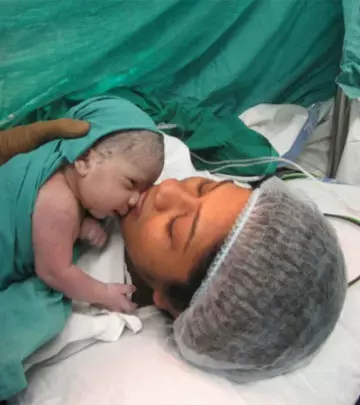
Image: iStock
Guess what happens when the doctor who delivered you also delivers your baby thirty years later! Lovely coincidence, don’t you think? And, your mother recommended the same doctor remain in service while approaching your due date too. But, this is exactly what happened to the first test-tube baby of Mumbai, who delivered a son. Amazingly, the doctor who oversaw her delivery happens to be the same who oversaw the now pregnant mom’s birth.
Mumbai’s first test-tube, Harsha Chawda is now the proud mom of a son. Harsha gave birth to a baby boy on Maha Shivratri, thirty years after she was born using in-vitro fertilization.
Harsha conceived her child naturally and needed no medical intervention, except a C-section to give birth.
Dr. Indira Hinduja is the lady behind the success of bringing both Harsha and her son into the world. Credited with bringing the first test-tube baby to life, she recalls the day when Harsha was born. She and her team were just as elated as the parents of Harsha at her birth. Now that Harsha herself has delivered a healthy baby weighing 3.18 kilos, she feels the same excitement that she felt thirty years ago.
Following her first test-tube baby product, Dr. Hinduja, and her team have delivered more than 15,000 test tube babies.
And, what makes it even better is that it’s not just Dr. Hinduja, but also the same team of doctors who delivered Harsha in 1986, who delivered her son as well! Harsha’s joy knows no bounds as she says, “I am God’s gift, and I believe my baby is also unique.”
While Harsha is ecstatic about having been blessed with a baby, her pregnancy goes on to show to show that children conceived through complex medical procedures can also conceive naturally without the intervention of similar medical techniques.
Both the mother and son are doing just fine though the couple is yet to pick a name for their son.
While in-vitro fertilization has come a long way in India, here are few facts you might want to know about it:
- In vitro fertilization involves fertilizing an egg outside a woman’s body that results from methods beyond sexual intercourse between a man and a woman, rather utilizing manipulating both the egg and sperm cells for successful fertilization.
- The term ‘test-tube baby’ was used to refer to children born through artificial insemination, i.e. before the progress in the in vitro fertilization technologies in the twentieth century.
- William Pancoast, a physician from Philadelphia, was the first to perform artificial insemination leading to a successful birth of a test-tube baby in 1884, although the success didn’t gather much public or media attention.
- It was only towards early twentieth century when media began to debate on the ethics of medical intervention in making a baby outside sexual intercourse.
- The discussions gradually moved on to spreading awareness and enlightening the public on in-vitro fertilization.
- An American biologist Landrum Brewer Shettles attempted the first human in vitro fertilization which wouldn’t be a success as opposed to the anticipation of the media. Look magazine had reported Landrum’s work in one of its issues titled “The Test Tube Baby Is Coming.”
- In vitro fertilization became common by 1960.
- It was not until 25 July 1978 when two British medical researchers Patrick Steptoe and Robert Edwards who created the first test-tube baby with what the revised definition of a ‘test tube baby’ meant. Their procedure involved fertilizing the egg outside the human body for the first time. The baby born was called Louise Brown. It was this breakthrough that made headlines around the world.
- The United States opened produced its first in vitro fertilization called Jordan Elizabeth Carr on 28 December 1981. By this time in vitro fertilization was widely accepted as the norm.
- However to this day, it is the work of Steptoe, Edwards, and Pancoast that sets the standardized definition of a test tube baby in that it refers to any child from an embryo created by a medical intervention that directly manipulates the sperm and egg cells.
- Dr. Subhash Mukhopadhyay was the first doctor from India (and second after Patrick Steptoe and Robert Edwards) who created the world’s second and India’s first test tube baby ‘Durga’ (alias Kanupriya Agarwal) using in-vitro fertilization on 3 October 1978. Dr. Mukhopadhyay committed suicide owing to the bureaucracy curtailing his achievements from being shared with the international community. He became a subject of discussion in several newspapers, his story inspiring even the making of a movie Ek Doctor Ki Maut.












